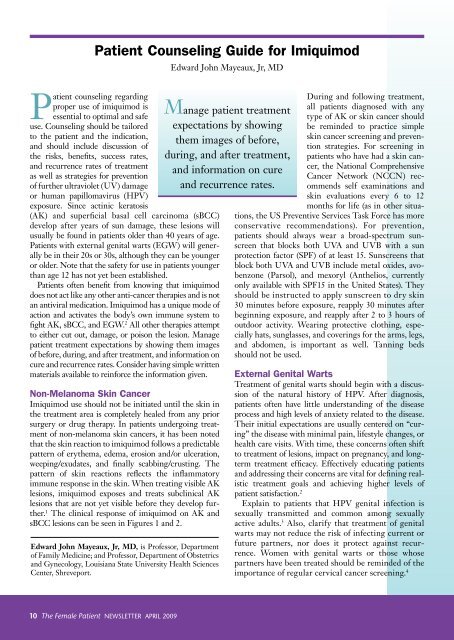Imiquimod: A Comprehensive Therapy - Ob.Gyn. News
Imiquimod: A Comprehensive Therapy - Ob.Gyn. News
Imiquimod: A Comprehensive Therapy - Ob.Gyn. News
You also want an ePaper? Increase the reach of your titles
YUMPU automatically turns print PDFs into web optimized ePapers that Google loves.
Patient Counseling Guide for <strong>Imiquimod</strong><br />
Edward John Mayeaux, Jr, MD<br />
Patient counseling regarding<br />
proper use of imiquimod is<br />
essential to optimal and safe<br />
use. Counseling should be tailored<br />
to the patient and the indication,<br />
and should include discussion of<br />
the risks, benefits, success rates,<br />
and recurrence rates of treatment<br />
as well as strategies for prevention<br />
of further ultraviolet (UV) damage<br />
or human papillomavirus (HPV)<br />
exposure. Since actinic keratosis<br />
(AK) and superficial basal cell carcinoma (sBCC)<br />
develop after years of sun damage, these lesions will<br />
usually be found in patients older than 40 years of age.<br />
Patients with external genital warts (EGW) will generally<br />
be in their 20s or 30s, although they can be younger<br />
or older. Note that the safety for use in patients younger<br />
than age 12 has not yet been established.<br />
Patients often benefit from knowing that imiquimod<br />
does not act like any other anti-cancer therapies and is not<br />
an antiviral medication. <strong>Imiquimod</strong> has a unique mode of<br />
action and activates the body’s own immune system to<br />
fight AK, sBCC, and EGW. 2 All other therapies attempt<br />
to either cut out, damage, or poison the lesion. Manage<br />
patient treatment expectations by showing them images<br />
of before, during, and after treatment, and information on<br />
cure and recurrence rates. Consider having simple written<br />
materials available to reinforce the information given.<br />
Non-Melanoma Skin Cancer<br />
<strong>Imiquimod</strong> use should not be initiated until the skin in<br />
the treatment area is completely healed from any prior<br />
surgery or drug therapy. In patients undergoing treatment<br />
of non-melanoma skin cancers, it has been noted<br />
that the skin reaction to imiquimod follows a predictable<br />
pattern of erythema, edema, erosion and/or ulceration,<br />
weeping/exudates, and finally scabbing/crusting. The<br />
pattern of skin reactions reflects the inflammatory<br />
immune response in the skin. When treating visible AK<br />
lesions, imiquimod exposes and treats subclinical AK<br />
lesions that are not yet visible before they develop further.<br />
1 The clinical response of imiquimod on AK and<br />
sBCC lesions can be seen in Figures 1 and 2.<br />
Edward John Mayeaux, Jr, MD, is Professor, Department<br />
of Family Medicine; and Professor, Department of <strong>Ob</strong>stetrics<br />
and <strong>Gyn</strong>ecology, Louisiana State University Health Sciences<br />
Center, Shreveport.<br />
Manage patient treatment<br />
expectations by showing<br />
them images of before,<br />
during, and after treatment,<br />
and information on cure<br />
and recurrence rates.<br />
During and following treatment,<br />
all patients diagnosed with any<br />
type of AK or skin cancer should<br />
be reminded to practice simple<br />
skin cancer screening and prevention<br />
strategies. For screening in<br />
patients who have had a skin cancer,<br />
the National <strong>Comprehensive</strong><br />
Cancer Network (NCCN) recommends<br />
self examinations and<br />
skin evaluations every 6 to 12<br />
months for life (as in other situations,<br />
the US Preventive Services Task Force has more<br />
conservative recommendations). For prevention,<br />
patients should always wear a broad-spectrum sunscreen<br />
that blocks both UVA and UVB with a sun<br />
protection factor (SPF) of at least 15. Sunscreens that<br />
block both UVA and UVB include metal oxides, avobenzone<br />
(Parsol), and mexoryl (Anthelios, currently<br />
only available with SPF15 in the United States). They<br />
should be instructed to apply sunscreen to dry skin<br />
30 minutes before exposure, reapply 30 minutes after<br />
beginning exposure, and reapply after 2 to 3 hours of<br />
outdoor activity. Wearing protective clothing, especially<br />
hats, sunglasses, and coverings for the arms, legs,<br />
and abdomen, is important as well. Tanning beds<br />
should not be used.<br />
External Genital Warts<br />
Treatment of genital warts should begin with a discussion<br />
of the natural history of HPV. After diagnosis,<br />
patients often have little understanding of the disease<br />
process and high levels of anxiety related to the disease.<br />
Their initial expectations are usually centered on “curing”<br />
the disease with minimal pain, lifestyle changes, or<br />
health care visits. With time, these concerns often shift<br />
to treatment of lesions, impact on pregnancy, and longterm<br />
treatment efficacy. Effectively educating patients<br />
and addressing their concerns are vital for defining realistic<br />
treatment goals and achieving higher levels of<br />
patient satisfaction. 2<br />
Explain to patients that HPV genital infection is<br />
sexually transmitted and common among sexually<br />
active adults. 3 Also, clarify that treatment of genital<br />
warts may not reduce the risk of infecting current or<br />
future partners, nor does it protect against recurrence.<br />
Women with genital warts or those whose<br />
partners have been treated should be reminded of the<br />
importance of regular cervical cancer screening. 4<br />
10 The Female Patient NEWSLETTER April 2009

















